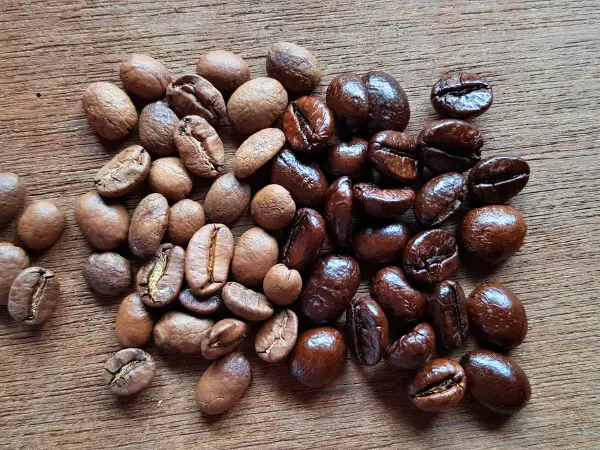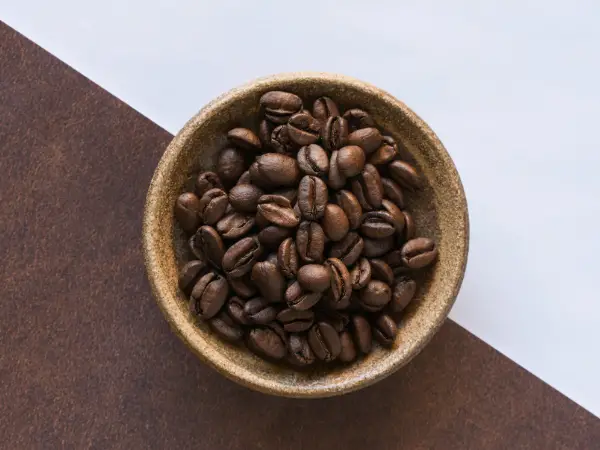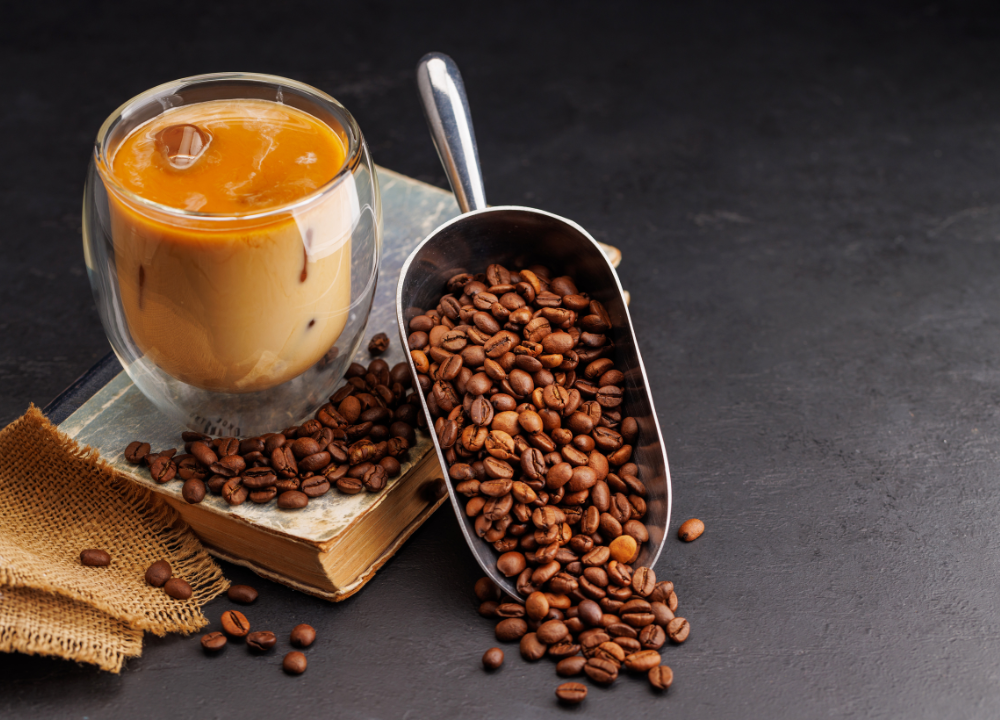Coffee lovers often debate the differences between light roast and dark roast. One question frequently arises: which one has more caffeine?
This guide will explore the caffeine content in both roasts, helping you choose your perfect cup.
Understanding Coffee Roasting And Caffeine
The roasting process affects the flavor and caffeine levels of coffee beans. It is essential to know how these factors work together to choose your perfect cup.
The Roasting Process: Light To Dark
The roasting process is crucial in determining the flavor and caffeine content of coffee. Coffee beans start as green beans. As they roast, they change in color and taste. The process has several stages:
- Drying Stage: Beans lose moisture and heat up.
- Maillard Reaction: Sugars and amino acids react, creating flavor.
- First Crack: Beans expand and crack, signaling light roast.
- Second Crack: Beans crack again, indicating a darker roast.
Roasting times vary:
| Roast Level | Time (Minutes) |
|---|---|
| Light Roast | 8-10 |
| Medium Roast | 10-12 |
| Dark Roast | 12-15 |
Light roasts are roasted for a shorter time. They retain more original flavors. Dark roasts have a bold, smoky flavor. They are roasted longer, which can change the caffeine content.
Caffeine Content: A Bean’s Natural Property
Generally, it is believed that light roasts have more caffeine. The longer roasting time for dark roasts can break down some caffeine.
Here are some key points:
- Light roasts: Higher caffeine levels due to shorter roasting time.
- Dark roasts: Slightly lower caffeine due to longer roasting time.
- Robusta beans: Contain more caffeine than Arabica beans.
Despite the differences, the amount of caffeine in a brewed cup also depends on brewing methods. For example, espresso has less caffeine per ounce, but a typical serving is smaller.
Density And Measurement: Key Factors
Light roasts tend to be denser than dark roasts. This means that when measuring coffee, the method used can impact caffeine levels. Different measurements yield different results.
Here’s how measurement affects caffeine:
- Weight: Light roast weighs more per cup than dark roast.
- Volume: A scoop of light roast contains more caffeine than the same scoop of dark roast.
To accurately compare caffeine levels, consider the following:
- Use the same type of bean.
- Measure by weight, not volume.
- Consider the brewing method.
Understanding these factors helps in making an informed choice between light and dark roasts.

The Light Roast Caffeine Myth
This belief is known as The Light Roast Caffeine Myth. It leads to confusion and misunderstandings about how caffeine actually works in different coffee roasts.
Popular Misconceptions Explained
People often think that light roast coffee has more caffeine than dark roast. This idea comes from a few common beliefs:
- Light roasts have a stronger flavor.
- Light roasts are less processed than dark roasts.
- People associate darker colors with stronger flavors and more caffeine.
These misconceptions can mislead coffee lovers. The truth is, the roast level does not directly determine caffeine content. Here are some facts:
| Roast Type | Caffeine Content (per 8 oz cup) |
|---|---|
| Light Roast | 95 mg |
| Dark Roast | 90 mg |
While light roast coffee may have a bit more caffeine, the difference is small. Many factors influence caffeine levels. The type of beans, brewing method, and serving size all play a role. It’s not just about the roast level.
Scientific Breakdown: Why It’s Not That Simple
Caffeine content is influenced by several scientific factors. The coffee bean itself is the primary source of caffeine. Different bean types have different caffeine levels. Here are some key points:
- Arabica beans have less caffeine than Robusta beans.
- The brewing method affects how much caffeine is extracted.
- Longer brewing times can lead to higher caffeine content.
Many studies show that light roasts and dark roasts can have similar caffeine levels. Here are some research findings:
- Brewing temperature impacts caffeine extraction.
- Grinding size affects how quickly caffeine leaves the bean.
These factors make it hard to say one roast has more caffeine than another. It’s not just about roasting time. It’s about how the coffee is brewed and the beans used.
The Role Of Bean Density
Bean density plays a crucial role in caffeine content. Light roast beans are less dense than dark roast beans. This is because dark roasting causes the beans to expand and lose moisture.
- Less moisture means lighter beans weigh less.
- A lighter bean can hold more caffeine per volume.
When measuring coffee by volume, light roast coffee may seem stronger. However, when measuring by weight, dark roasts can have a similar caffeine level.
Here’s a simple comparison:
| Measurement Type | Light Roast | Dark Roast |
|---|---|---|
| By Volume (1 cup) | Higher caffeine | Lower caffeine |
| By Weight (1 oz) | Lower caffeine | Higher caffeine |
Understanding bean density helps clarify the caffeine debate. It’s important to consider how you measure coffee. This can change your perception of caffeine levels.

The Dark Roast Caffeine Reality
The roasting process affects caffeine content. Understanding this helps coffee lovers make better choices. Let’s explore the dark roast caffeine reality.
Volume Vs. Weight: Measuring Caffeine
Caffeine content varies based on how coffee is measured. There are two main ways to measure coffee: by volume and by weight. This difference significantly affects the caffeine you get from your cup.
- Volume: This refers to how much coffee is used in cups or ounces.
- Weight: This measures the actual weight of the coffee beans in grams.
When comparing light and dark roasts, the measurement method matters.
| Type of Roast | Caffeine per 1 ounce (by weight) | Caffeine per 1 tablespoon (by volume) |
|---|---|---|
| Light Roast | 95 mg | 60 mg |
| Dark Roast | 90 mg | 45 mg |
From the table, light roast has slightly more caffeine by weight, while dark roast has less caffeine per volume. This shows that weight-based measurements can reveal different caffeine levels than volume measurements.
How Roasting Affects Bean Weight
The roasting process changes the weight of coffee beans. Light roast beans are denser than dark roast beans. As beans roast longer, they lose moisture and weight.
This weight loss can be significant. Typically, light roast retains more of its original weight. Dark roast can lose up to 20% of its weight. This difference affects caffeine concentration.
- Light Roast: More dense, retains weight.
- Dark Roast: Less dense, loses weight during roasting.
This means when you brew, dark roast may seem lighter. If you measure by volume, you might end up with less caffeine.
Practical Implications For Your Brew
When brewing coffee, knowing the differences between light and dark roast can impact your experience. If you prefer stronger coffee, consider using light roast.
Here are some practical tips:
- Measure by weight: Use a scale for better caffeine accuracy.
- Adjust brewing method: Dark roast may require more coffee to match the caffeine of light roast.
- Experiment: Try different roasts to find what works best for you.
Understanding these factors can enhance your coffee enjoyment. Choose the roast that fits your taste and caffeine needs.
Factors That Actually Affect Caffeine Content
Several factors affect caffeine content. Understanding these factors helps in knowing what to expect from your cup of coffee.
Bean Variety: Arabica Vs. Robusta
Coffee beans come in different varieties, and this affects caffeine levels. The two most popular types are Arabica and Robusta.
- Arabica: This type has less caffeine, around 1.2% to 1.5% per bean.
- Robusta: Robusta beans contain more caffeine, about 2.2% to 2.7% per bean.
Here’s a quick comparison:
| Bean Type | Caffeine Content (%) |
|---|---|
| Arabica | 1.2% – 1.5% |
| Robusta | 2.2% – 2.7% |
Robusta beans are often used in espresso blends. Their higher caffeine level gives a stronger kick. Arabica beans are smoother and have a milder flavor.
Brewing Methods: Extraction Differences
The way you brew coffee affects how much caffeine ends up in your cup. Different methods extract caffeine differently. Here are some common brewing methods:
- Drip Coffee: Uses hot water to extract caffeine. Typically results in moderate caffeine levels.
- Espresso: Uses pressure to extract flavor and caffeine quickly. A small shot has concentrated caffeine.
- French Press: Steeps coffee for longer. Can result in a higher caffeine content.
The extraction time plays a big role. Longer extraction often means more caffeine. Understanding your brewing method helps control caffeine intake.
Grind Size And Water Temperature
Grind size and water temperature are key factors in caffeine extraction. Finer grinds allow more surface area for extraction. This means more caffeine in your cup. Here’s how these factors interact:
- Finer Grind: Increases extraction. Ideal for espresso and French press.
- Coarser Grind: Slower extraction. Better for cold brew or percolated coffee.
Water temperature also impacts caffeine levels. Hotter water extracts caffeine faster. Most brewing methods work best between 195°F to 205°F (90°C to 96°C).

